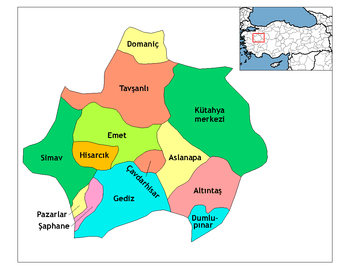Altıntaş
Altıntaş is a town and a district of Kütahya Province in the Aegean region of Turkey.
Altıntaş | |
|---|---|
 Altıntaş | |
| Coordinates: 39°03′41″N 30°06′35″E | |
| Country | Turkey |
| Province | Kütahya |
| Area | |
| • District | 946.70 km2 (365.52 sq mi) |
| Population (2012)[2] | |
| • Urban | 5,313 |
| • District | 17,780 |
| • District density | 19/km2 (49/sq mi) |
History
Altıntaş was previously known as "Kurtköy".[3] The district's name means "golden stone" in Turkish and was given due to the large stone deposits, especially marble deposits in the area.[4]
Chalcolithic artifacts have been found in the Altıntaş area. The Roman city of Soa is located within the district boundaries. The marble in the area was mined in antiquity, having been used in the construction of the ancient city of Aizanoi nearby. Near today's Pınarcık village, a Roman city called "Abya" produced its own coins. In the Osmaniye village, a mausoleum from the 2nd or 3rd century AD was excavated.[3][5] In the district center of Altıntaş, a tomb called the Seydisül Tomb, built in the late 19th or early 20th century, contains an arch from the Byzantine era, depicting Deesis.[6]
During the reign of the Ottoman sultan Bayezid II, a rebellion was suppressed at a battle in Altıntaş.[3]
Early in the Greco-Turkish War during the Turkish War of Independence, the area was occupied by the Greek forces. Parts of the Battle of Dumlupınar took place within the district boundaries; these areas were later declared a national park. Altıntaş became a district in 1947.[3]
References
- "Area of regions (including lakes), km²". Regional Statistics Database. Turkish Statistical Institute. 2002. Retrieved 2013-03-05.
- "Population of province/district centers and towns/villages by districts - 2012". Address Based Population Registration System (ABPRS) Database. Turkish Statistical Institute. Retrieved 2013-02-27.
- "Tarihçe". Altıntaş Directorate of Food, Agriculture and Husbandry. Archived from the original on 27 December 2015. Retrieved 26 December 2015.
- Altınkaynak Duğan, Seher. "KÜTAHYA'NIN ALTINTAŞ KÖYÜNDE BULUNAN SEYDİSÜL TÜRBESİNDEKİ DEESİS SAHNESİ" (PDF). Kütahya Museum. Retrieved 26 December 2015.
Adını bile taş zenginliğinden alarak Altıntaş olan bu köy ve Altıntaş İlçesi, Antik Dönemden beri taş ocakları ile önemli bir bölgedir. / The Altıntaş village and the Altıntaş district, which are named after their abundance of stones, have been important since antiquity thanks to their quarries.
- "Kütahya tarihçesi". Zaman. 1 July 2007. Retrieved 26 December 2015.
- Altınkaynak Duğan, Seher. "KÜTAHYA'NIN ALTINTAŞ KÖYÜNDE BULUNAN SEYDİSÜL TÜRBESİNDEKİ DEESİS SAHNESİ" (PDF). Kütahya Museum. Retrieved 26 December 2015.
